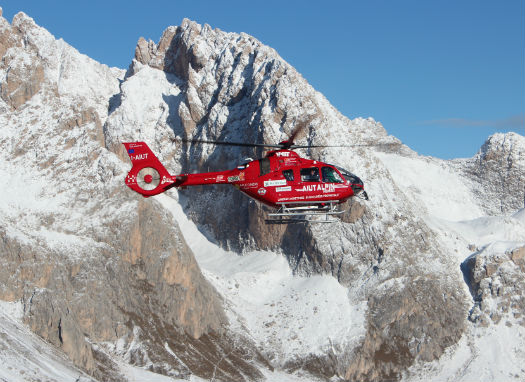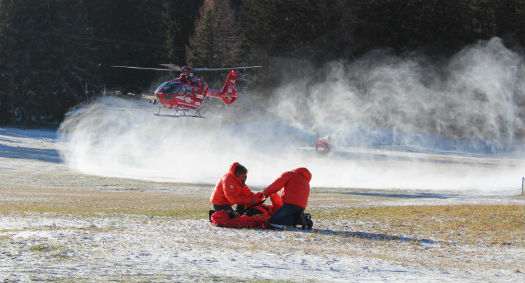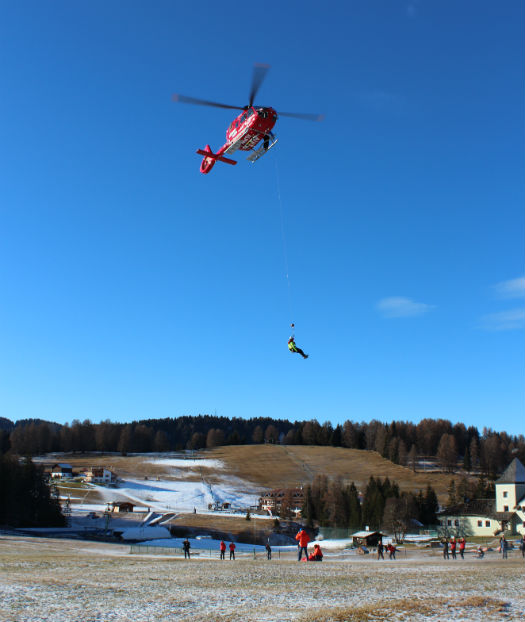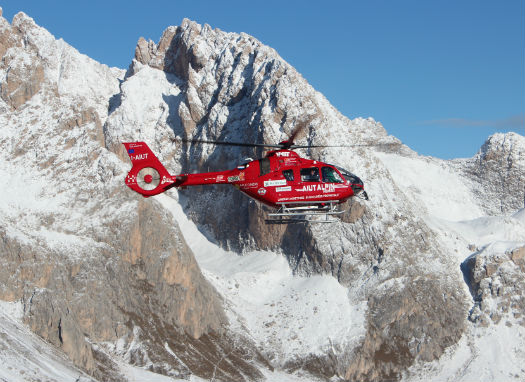
Aiut Alpin Dolomites marked the entry into service of the Airbus Helicopters EC135 T3 on Dec. 9 in northern Italy. Andrew D. Parker Photos
There are few places in the world more scenic — and more challenging for helicopter emergency medical services (HEMS) providers — than the Alps. Injuries that require a medical evacuation throughout the high altitude region, which stretches across parts of eight countries in Europe, are so time-critical that instead of airlifting a patient to a hospital, operators many times bring the necessary paramedics and equipment directly to the patient.
This is especially true in the Dolomites region in northeastern Italy, which houses a number of jagged snow-capped rock formations that are popular among climbers in the summer and skiers in the winter. It is also home to Aiut Alpin Dolomites, a nonprofit HEMS and search-and rescue operation nestled within the Dolomites mountain range. Representatives of the unit and Airbus Helicopters marked the entry-into-service of the first EC135 T3 on Dec. 9, in a ceremony complete with a demo flight, tours of the home base for Auit Alpin Dolomites and an Italian bishop blessing the aircraft.

The service entry ceremony included a mock demo of a rescue mission.
The unit is the launch operator for the type, which has two versions. The T3 is a variant with two Turbomeca Arrius 2B2 Plus engines and the P3 version features a pair of Pratt & Whitney PW206B3s. The P3 version is scheduled to enter service in early 2015.
Dr. Lydia Rauch, medical director for Aiut Alpin Dolomites, explained that the upgrade to the EC135 T3 was primarily due to new regulations put in place recently for European HEMS operators. The helicopter has a number of improvements that will increase the efficiency of rescue operations, including new radio and navigation techniques, new processes for winching, improved range and better hot-and-high performance. Medical tools on board include a defibrillator, suction equipment, respirator, oxygen bottles, emergency and pediatric backpacks, a vacuum mattress and a winch bag.

The main base of Aiut Alpin is situated within the Dolomites mountain range. Shown here is the new EC135 T3 on the helipad with the T2 version below.
Another advantage with the EC135 T3 is the ability to load the patient through the side door without having to land. “You put the winch down, perform all the medical needs for the patient, hook the patient back into the winch, and then one person — usually the doctor or mountain rescuer — can go with the patient up to the helicopter,” Rauch said. “In the air, we get in with the patient, close the door and go to the hospital. The usual procedure is that there has to be an intermediate landing to take in the patient.”

Winch and long rope operations are essential for Aiut Alpin Dolomites, which carries out missions in steep terrain.
![]()
According to Airbus Helicopters Germany CEO Wolfgang Schoder, the T3 version features a number of additional capabilities. Aiut Alpin currently operates an EC135 T2, which will eventually be transferred to another rescue operation and serve as a backup when needed.
“The first thing they told me today was now we can go on all those missions with high safety margins, including a full tank of fuel, as well as having all the doctors and medical equipment on board that we need, so that we don’t need to think about the performance of the helicopter. This is a big step forward for them,” Schoder told Vertical. In addition to a higher maximum takeoff weight of 2,980 kg (around 6,500 pounds) improvements include a newly designed multifunctional floor for air medial missions, removing the need for a second layer of flooring.

Teams from Aiut Alpin Dolomites (wearing orange, green and light blue jackets) and Airbus Helicopters (dark blue jackets) gather to mark the entry into service of the new EC135 variant.
The EC135 T2 and T3 are produced at the Airbus Helicopters plant in Donauwörth, Germany, along with the EC145 C2 and T2 variants, as well as the EC635 and EC645 (military versions of the EC135 and EC145, respectively). The plant also produces the Tiger attack helicopter and NH90, along with a CH-53 upgrade program for the German Army and composite doors for the fixed-wing A350 XWB airliner.![]()
With origins tracing back to 1985, Aiut Alpin Dolomites consists of 17 mountain rescue groups, comprised of doctors, pilots, hoist operators and dog handlers. The unit first operated an Aérospatiale Alouette III, before transferring to various Eurocopter (now Airbus Helicopters) Ecureuil variants — the AS350B, B1, B2 and B3 — through 2003. Since then, Aiut Alpin has operated the EC135, transitioning from the T1 to the T2 and T2i. The operation has responded to upwards of 700 calls in 2014 so far, and close to 13,000 emergency situations since opening its doors. ![]()









